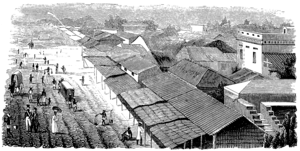
| This list is incomplete; you can help by adding missing items. (October 2021) |
The Urdhvalokas (Sanskrit: ऊर्ध्वलोक, romanized: Ūrdhvaloka) or upper spheres of the world, are composed of seven lokas or worlds, according to Hindu mythology. The detailed explanation of them is found in the Vishnu Purana. The three highest lokas (realms), Jana, Tapa, and Satya are styled as durable, while Maharloka, has a mixed character; for although it is deserted at the end of the kalpa (aeon), it was not destroyed yet.
List of lokas
Bhuloka

The sphere of the Earth or Bhuloka (‘Bhu’ means ‘Earth’ and ‘loka’ means the surface of the Earth), comprehending its oceans, mountains, and rivers, extends as far as it is illuminated by the rays of the Sun and Moon; and to the same extent, both in diameter and circumference, the sphere of the sky (Bhuvaloka) spreads above it (as far upwards as to the planetary sphere, or Svargaloka).
Bhuvarloka
The region, where the siddhas and other celestial beings move, is the Earth's atmospheric sphere which also contains space which has its neighbouring planets in the Solar System along with stars and comets. It is also where arhats, siddhas, bodhisattvas, buddhas reside.
Svargaloka
The interval between the Sun and Dhruva, extending fourteen hundred thousand leagues, is inhabited by the devas, including devis with their king Indra and its references make it equivalent to the Svarga (heaven), while some Puranic references equate Svargaloka to the Solar System.
Maharloka
Above Dhruva, at the distance of ten million leagues, lies the sphere of saints, or Maharloka, the inhabitants of which dwell in it throughout a kalpa, or day of Brahma.
Janaloka
At twice that distance is situated Janaloka, where the Sanandana (Four Kumaras) and other pure-minded children of Brahma reside.
Tapaloka
At four times the distance, between the two last, lies the Tapaloka (the sphere of penance), inhabited by the immortal beings and deities called Vaibhrájas, who are highly knowledgeable, pure, and enlightened, whereby they can easily travel to the uppermost realm, Satyaloka, are unconsumable by fire of destruction during the dissolution of the universe.
Satyaloka
It is highest plane of consciousness or the highest of the heavenly realms. It is also called Brahmaloka where Brahma and his consort, Saraswati, reside. It is six times the distance (or twelve crores, a hundred and twenty millions of leagues) and is referred to as the sphere of truth, where all the knowledge is available and the inhabitants never die, become old, become ill, have pain and anxiety.
See also
References
- The Sacred Scriptures of India. Anmol Publications. 2009. p. 195. ISBN 978-81-261-3630-8.
- Publications, Himalayan Academy (2007). What is Hinduism?: Modern Adventures Into a Profound Global Faith. Himalayan Academy Publications. p. 398. ISBN 978-1-934145-00-5.
- Aiyangar, K. (December 2004). Some Contributions of South India to Indian Culture. Cosmo Publications. p. 86. ISBN 978-81-7755-744-2.
- Prabhupada, His Divine Grace A. C. Bhaktivedanta Swami (1976-12-31). Srimad-Bhagavatam, Eighth Canto: Withdrawal of the Cosmic Creations. The Bhaktivedanta Book Trust. p. 443. ISBN 978-91-7149-641-6.
- Soifer, Deborah A. (1991-01-01). The Myths of Narasimha and Vamana: Two Avatars in Cosmological Perspective. SUNY Press. p. 52. ISBN 978-0-7914-0799-8.
- Soifer, Deborah A. (1991-01-01). The Myths of Narasimha and Vamana: Two Avatars in Cosmological Perspective. SUNY Press. p. 52. ISBN 978-0-7914-0799-8.
- Garrett, John (2023-03-28). Classical Dictionary of India. BoD – Books on Demand. p. 635. ISBN 978-3-382-16152-1.
- "ŚB 2.2.27". vedabase.io. Retrieved 2021-10-09.
![]() This article incorporates text from The Vishnu Purana, translated by Horace Hayman Wilson, 1840, at sacred-texts.com, a publication from 1840, now in the public domain in the United States.
This article incorporates text from The Vishnu Purana, translated by Horace Hayman Wilson, 1840, at sacred-texts.com, a publication from 1840, now in the public domain in the United States.